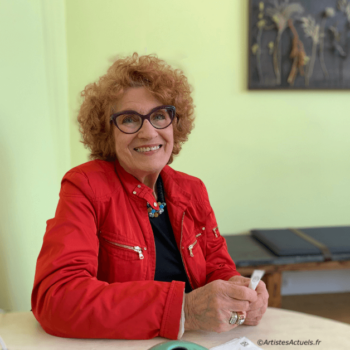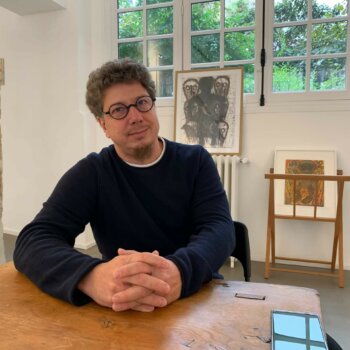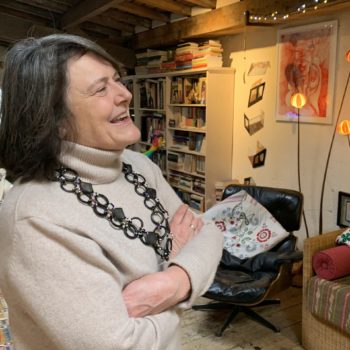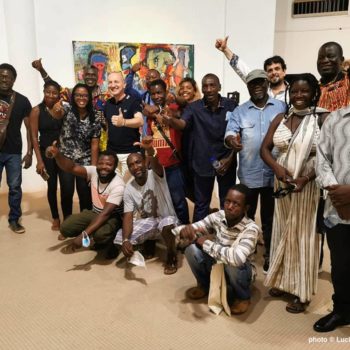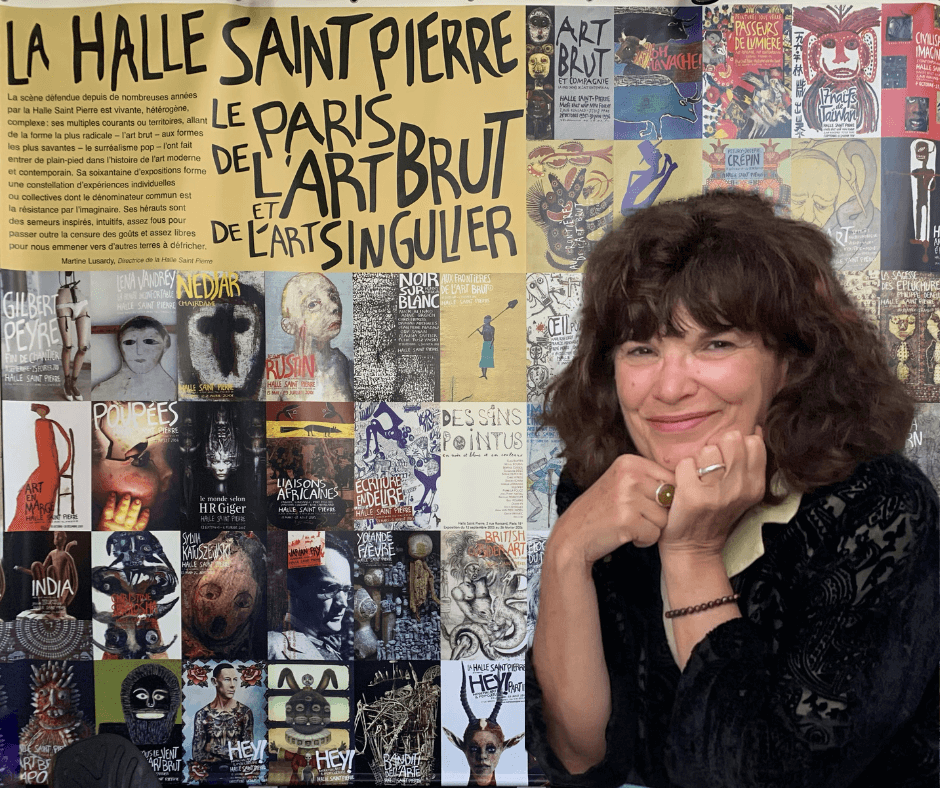
Martine Lusardy lives, dreams and dialogues with outsider imaginations.
- Post published:15 March 2025
- Post category:Art activists
Since 1994, Martine Lusardy has directed La Halle Saint Pierre, a cooperative-minded Parisian museum whose primary mission is to exhibit all forms of outsider creation: art brut, outsider art, contemporary folk art. La Halle Saint Pierre’s thematic exhibitions, as well as those dedicated to the Outsider Art of a country, are part of a prospective approach that defies the market. Martine Lusardy explains that visitors come to La Halle Saint Pierre not for knowledge, but for a sensitive experience.
Her adventure with La Halle Saint Pierre and Outsider Art is fascinating. Artistes Actuels gives you a glimpse.
Making the invisible visible is the original mission of the museum
In the 1980s, artists, collectors and Outsider art lovers were feeling abandoned by the departure of Jean Dubuffet’s collection to Lausanne. What’s more, outsider art remained confidential, despite the great success of the exhibition “Les singuliers de l’art” at the Museum of Modern Art of the City of Paris (MAMVP) from January 19 to March 5, 1978.
Opened in 1986, La Halle Saint Pierre then housed two entities, the “musée en herbe” and a museum of naive art. A pioneer in this field, the Musée en herbe offered educational activities and artistic workshops for children. It was imitated by most museums and lost its appeal. The Musée d’Art Naïf, limited to a collection focusing on Yugoslav socialist realism of the 70s, without any of the great names in naive art, will have great difficulty in making its programming more dynamic. In 1994, these two entities were replaced by the present museum, headed by Martine Lusardy.
Her first exhibition, “Art Brut et Cie, la face cachée de l’art contemporain”, ushered in a new era by bringing together the French-speaking collections of Outsider Art: Lausanne, L’Aracine collection. La Fabuloserie, musée de la Création franche de Bègles, Cérès Franco collection and the small Musée du Bizarre in Ardèche.
"Art Brut", a history of passionate encounters between the imaginary and the singular
While interest in Art Brut now reaches the general public as well as collectors, institutions, research, the media and the art market, for a long time it was confined to a few enlightened enthusiasts. It should not be forgotten that interest in ‘Art Brut’ developed from “private collections built up by artists whose eye, rich in the experience of creation, is able to spot the originality and artistic singularity of others”: the Dubuffet collection, the Alain Bourbonnais collection, the L’Aracine collection in particular.
Art Brut is linked to the personality of Jean Dubuffet, who brought together under his name “Art Brut” art forms that had previously been marginalized, not belonging to any school or artistic movement.
“Dubuffet’s approach is not aesthetic but anthropological. He is interested in creation not only from an artistic point of view, but also from a social and mental one. He develops a highly critical analysis of the dominant elitist culture, which confines creation to norms. He overturns the frame of reference of values, demonstrating that artistic genius can be found in the common people, that there is no need for cultural capital or knowledge to create and to be worthy of interest”.
Martine Lusardy, talent explorer, prospector and passionate art activist
“A museum that collects exhibitions "
A museum, by definition, has a double mission: to conserve and to educate. La Halle Saint Pierre doesn’t have any collections to preserve, it shows and collects exhibitions: it has 90 to its credit.
Since “Art Brut et Cie, la face cachée de l’art contemporain”, the museum has developed an active network of relationships with artists, collectors and other institutions around the world.
With her team or with outside curators, she explores beyond the original Western roots of Dubuffet’s discoveries: USA, Brazil, Japan or Iran…
Her collaborations with private collections reveal another side to the notion of collecting: in contrast to the institutional collection based on the “objective” criteria of art history, the private collection based on the collector’s passion is subjective. The latter allows oneself associations and dialogues between works, regardless of schools and movements.
Her exchanges with foreign curators help her to build exhibitions that vary from one point of view to another.
Personally, Martine doesn’t collect art, but she lives with it and dreams about it. Works of art are her inner wealth; she doesn’t need to own them.
La Halle Saint Pierre is a collective success, that of its 16-strong team who, in addition to running the exhibitions, also run the bookshop, café and free-entry gallery on the ground floor. La Halle Saint Pierre’s exhibitions and bookshop are closely linked. The bookshop, founded in 1986 by Pascal Hecker and Laurence Maidenbaum, is of course specialized in Art Brut, but its rigorous selection also highlights the cultures of the countries featured in the exhibitions (Brazil, Japan, Iran…).
If contemporary art has its sponsors and afficionados, Outsider Art has its Public
At La Halle Saint Pierre, the large and varied audience largely finances the budget. Its success is based on a subtle balance:
“giving the public what they want to see, while taking them further by offering them an experience based on the sensitive and the imaginary. To help them discover, through other cultures, an artistic and cultural elsewhere, with other visions and representations of the world”.
Exhibitions at La Halle Saint Pierre are benchmarks in their field. Martine Lusardy has a gift for spotting talent and presenting it. She places great value on human relationships, both in her role as exhibition curator and in the life of the place via the café, bookshop and RDC gallery.
Outsider Art, an art of resistance to market forces
Martine Lusardy believes that Art Brut, as an art of resistance (resisting the loss of our childhood innocence), will always resist market forces.
“People locked up in Asylums, cast out of society, were objects of study, “rejects”, no longer considered human beings: they were clinical cases.
Through their creative work, the inmates became subjects once again, regaining their self-esteem. Creating enabled them to straighten up, rebuild their dislocated egos and become subjects of their own lives once again.
They created freely and disinterestedly, without regard for the gaze or judgment of others.
A few humanist psychiatrists and enlightened enthusiasts began to look at them from an artistic rather than a clinical point of view.”
In this way, Art Brut breaks down categories and concepts.
“Seeing the works of Art Brut makes you more sensitive to otherness, to difference.”
On the market, the prices achieved by Art Brut seem quite modest compared to those of contemporary art (€600,000 maximum versus tens of millions).
“Speculators, by definition, are looking for a quick return on their investment, but Art Brut requires a long wait to see a price jump, and there’s a lot of incertitude surrounding discoveries. With the exception of the historical artists present in Lausanne, the stability of their quotations is guaranteed.”
The Art Brut market remains too volatile and uncertain.
“Art brut resonates with us because it is profoundly human. It arises from an inner need that unites thought, body and emotion without dissociation. The creators of Art Brut fascinate us, touch us and move us, because they broaden our vision of reality by following the magical, supernatural, irrational paths of the imaginary, which our familiar worlds have hidden.”
Art Brut shows us what we have lost, the child in us that has disappeared: and that can’t be bought!
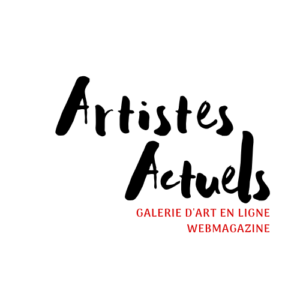
La rédaction
Plaisir et émotion des découvertes artistiques

